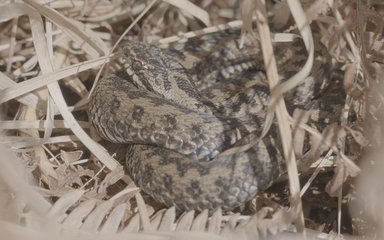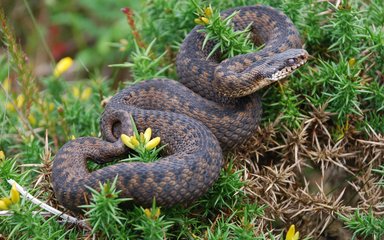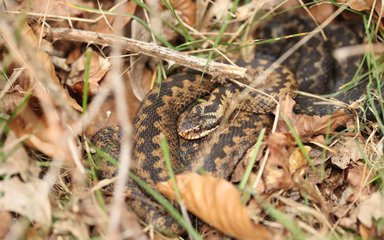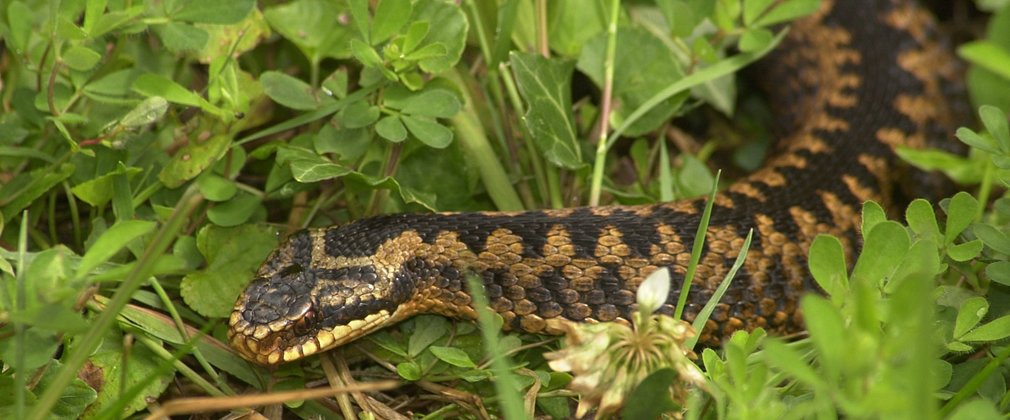The common European adder (Vipera berus) is a native UK species that has been in decline for many years. Adders are now only found in a handful of places, including Haldon Forest.
Read on to find out more about this shy species and how we’re supporting the adder population at Haldon Forest.

All about adders
Adders can live up to 15 years in the wild and grow up to 80cm long - although most are much smaller. Adders can be identified by the distinctive zigzag pattern along their back. The pattern appears on adders of all ages and is usually shades of grey, brown, or black. Males are often lighter in colour than females. Their pattern gives adders excellent camouflage in shrubby undergrowth, where they find sheltered spots to bask in the sun.
Adders are most active from spring to autumn and during sunny weather. They hunt mainly for small mammals, but will also eat reptiles, birds, and frogs. Adders also forage eggs from bird nests on the ground.
How adders breed
When adders emerge from hibernation in the spring, they bask in the sun to restore their energy. The exact timing of their emergence and breeding season depends on the weather - the sunnier, the better.
Male adders compete to win access to breeding females. Adders are unusual among snakes because the female doesn’t lay eggs. Instead, she gives birth to a litter of up to 20 live young around four to five months after mating. Newborn adders, called neonates, are independent almost immediately. They will quickly set out into the forest to fend for themselves by finding food and shelter.
Adders at Haldon Forest
Adders are cold-blooded (ectothermic), so they rely on external sources of heat (the sun) to regulate their body temperature. This means they need sunny spots to bask in the sun, preferably with nearby shelter, such as bramble, heather, and long grass. Adders hibernate during the winter months, so they also need safe places to rest, like old mammal burrows or log piles.
Adders are an important part of the forest ecosystem. They are also an indicator species. This means that whatever is happening to adders is likely to be happening to other species. If numbers of adder are falling, other species that depend on the same habitats are likely to be suffering too.
Haldon Forest habitats
Haldon Forest’s combination of wooded areas and open space provide all the features that adders need. Haldon’s lowland heath habitat is one of the reasons the forest is designated a Site of Special Scientific Interest (SSSI). We are gradually restoring Haldon’s heathland by increasing the amount of heathland habitat and joining up existing areas. This will provide more habitat for a variety of species including adders, ground-nesting birds, and heathland-specific plants.


Where are the adders?
We are working with adder conservation expert, Nigel Hand, to learn more about adder behaviour at Haldon Forest. Using radio tracking technology, we can better understand where adders bask and breed in the forest. In the past, we have used habitat to make assumptions about where adders are likely to be. This new approach will help us to understand much more accurately where adders are and when.
Better understanding of where adders are will help us to protect them by focusing our heathland management on the most important areas, making sure that adders are protected during forest management work, and keep them safe from visitors.
Are adders dangerous?
No. Adders are often wrongly thought to be dangerous because they are venomous. In fact, adders are shy creatures and bites are very rare. Most bites happen when a snake is disturbed and it tries to defend itself.
An adder bite is very unlikely to be deadly to a human but it can make you feel very unwell and you should seek medical attention straight away. Dogs that are bitten should be taken to a vet immediately.
Did you know? The last human death from an adder bite was in 1975.
How can we help adders?
One simple thing we can all do to help protect vulnerable adders, is to keep ourselves and dogs on official trails when visiting the countryside. Adders are well camouflaged so it's easy to disturb them when we can't see where they are.
If you come across an adder, move away quietly. Don't try to pick up or move an adder or get closer for photos. A snake doesn’t have to be physically injured to be harmed. Every time the snake is disturbed, it interrupts breeding behaviour and drains its energy, which puts the whole population at risk.
Stay on waymarked trails to give nature space.

